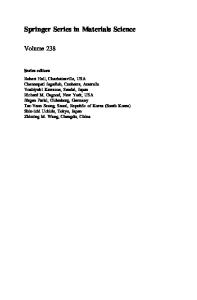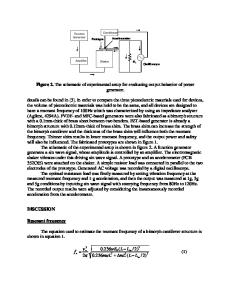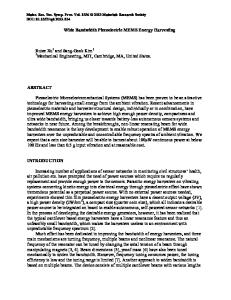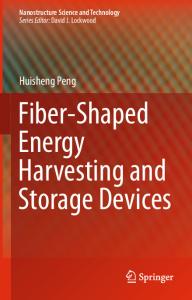Piezoelectric Materials and Devices for Wind Energy Harvesting
- PDF / 352,415 Bytes
- 6 Pages / 432 x 648 pts Page_size
- 118 Downloads / 441 Views
Piezoelectric Materials and Devices for Wind Energy Harvesting John Lake1,2, Jiyuan Luan1,3, Zuki Tanaka1,2,3, Bin Liang1,3 and Bin Chen1, 3 2
1 NASA Ames Research Center, Moffett Field, CA NASA internship fellow, Department of Mechanical Engineering, Columbia University, NY 3 Department of Electrical Engineering, University of California, Santa Cruz CA
Keywords: Piezoelectric polymers, carbon nanotubes electrodes, capacitance storage Abstract We present materials development in fabricating thin film devices for the conversion of wind energy as a sustainable energy source. We demonstrate the feasibility of piezoelectric polymer thin film devices to harvest wind energy in a miniature wind tunnel. Using an example of prototype device based on polyvinylidene fluoride (PVDF) thin film devices, we are able to obtain electrical power from the wind’s energy through the mechanical deformation of PVDF, such as that obtained from the films flapping in the wind. We have obtained a preliminary result of 1 PW power (at 15 mph wind) with a single layer of PVDF of 4 x 2 inches and 50 μm in thickness sandwiched between two thin gold electrode films. Additionally, the fracturing of metallic electrodes over time from the induced strain of this application lead to the significance of examining carbon nanotubes as compliant electrodes offering better mechanical properties while maintaining necessary electrical properties. Introduction Nanotechnology and nanomaterials have enabled unprecedented device performances in very compact packages. In particular, it is crucial to precisely control the interfacial interactions of liquid and solid phases. Using an example of a prototype device based on polyvinylidene fluoride (PVDF) thin film devices, we are able to obtain electrical power from the wind’s energy through the mechanical deformation of PVDF, such as that obtained from the films flapping in the wind. Such polymer materials have low manufacture cost and low form factor, so they can be easily molded to many device configurations. For example, piezoelectric polymer materials can be integrated into parts of wind turbine blades and micro robots, or power generators for “self powered” wind sensors. However, the energy conversion efficiency largely depends on the performance of the electrode materials, including the conductivity for charge collection efficiency and reliability for the device’s lifetime. Our recent investigation shows that the most critical issue in piezoelectric polymer thin film devices is the fatigue of metal thin film electrodes caused by the induced mechanical strain from the applications. To avoid the metal cracking, commercially available non-metal conductive epoxies are used for electrodes for these high strain energy harvesting polymer devices. These thicker electrode materials dampen the mechanical strains necessary to take advantage of the PVDF’s potential for energy harvesting. No commercially available electrodes for these thin film devices currently exist. However, our previous results of carbon nanotubes (CNT
Data Loading...











